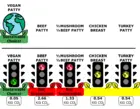
Making Sustainable Choices Possible
Even when consumers want to make sustainable food choices, they may not know which choices are sustainable. A new study from YCCI and food experts at Google gives guidance on effective labeling practices that enable planet-friendly decisions.
With the UN estimating that food production accounts for more than one third of all global greenhouse gas emissions, it’s no surprise that consumers have taken an increasing interest in understanding the relationship between the foods they eat and the climate.
One report predicts that by 2030, environmental impact will be as important a determinant of food choices as taste, cost, and nutrition. Despite this increased interest in selecting more sustainable choices, many consumers can be confused about which foods are climate friendly.
Take the case of the restaurant menu. Meat consumption alone accounts for roughly 15% of human-caused greenhouse gas emissions, with beef and lamb accounting for roughly 10%. That means the choice between entrées represents a critical step in averting global climate change. But is a lamb burger or chicken breast preferred to a burger that is made with 50% beef and 50% mushroom? What strategies can purveyors use to aid consumers in making thoughtful decisions about what to eat?
A small but growing body of research suggests that using sustainability labels may help consumers make more planet-friendly choices. One study found that using icons that represented sustainability scores (A-E) led participants to choose more sustainable foods. Other work has shown that providing consumers with numeric information about the emissions of different foods (e.g., the KG of CO2 required to produce the food) decreases selection of unsustainable choices. These early successes have led to restaurants such as Panera to implement sustainability labels of their own.
Notably, however, there are many different types of labels: restaurants can use numbers, icons, or combine the two. Further, these labels can range from the simple and easy to understand (e.g., a green footprint icon on sustainable choices) to more nuanced, but more complex, ranking scales. At present, there is no clear guidance on what makes for an effective labeling system.
A recent partnership between researchers at the Yale Center for Customer Insights and food experts at Google sought to understand what types of labels are most effective, and which are least likely to generate negative backlash. In this paper, recently published in the Journal of the Association for Consumer Research, these researchers compared the effectiveness of different types of sustainability labels.
In one study, participants were presented with a ‘build-your-own-burger’ restaurant menu and instructed to construct their preferred burger. The researchers were primarily interested in what type of patty participants selected, with the options being full beef, half-beef/half-mushroom, chicken breast, turkey patty, and veggie burger.
In the control condition, participants simply made their choice of patty, but in the treatment conditions, the researchers presented the patty options alongside different types of sustainability labels. One labeling approach used a traffic-light icon where every food was labeled with a green (veggie patty), yellow (chicken/turkey), or red (beef) traffic-light icon to indicate how sustainable that food was. Another condition simply labeled the sustainable option with a green globe icon (and had no label for the other options). A third condition displayed the KG of CO2 emissions for each option. A fourth and fifth condition combined the CO2 information with each of the two icon labels. Finally, the researchers asked participants what their overall opinion was of the restaurant on a 7-point scale.
The researchers then analyzed the carbon impact of the choices participants made. They found 3 things. First, all the sustainability labels led to significantly lower carbon emissions compared to control. Second, the traffic light labels led to significantly lower carbon emissions compared to any of the other labels. Notably, however, the traffic lights also made participants like the restaurant significantly less compared to the other conditions. Third, combining the single globe icon with numeric information was more effective than either the globe or the numeric information on its own, and did not lead to negative attitudes towards the restaurant.
The irony that effective labeling systems may also alienate consumers could be a major impediment to restaurants voluntarily adopting these labels. If there is an intuition that sustainability labels make customers like their restaurant less, restaurants may not implement them at all. This is all the more important because, when the researchers replicated these findings using different restaurants, real choices, and different populations, they found that the introduction of labels decreased carbon emissions by 25-40%, suggesting they can dramatically reduce the carbon footprint of our choices.
The researchers were quick to note that these numbers need to be replicated outside of the laboratory before we know how strong the effects truly are. Nevertheless, this work offers a number of important takeaways:
- Any label is better than nothing when it comes to encouraging sustainable food choices.
- Traffic-light labels can outperform other sustainability labels, but risk alienating customers.
- Highlighting sustainable options (e.g., with a globe icon) combined with numeric information for all options appears to be both effective and does not produce negative backlash.
“For those in the food industry interested in helping their customers make planet-friendly choices, it seems like sustainability labels can really help” said Center for Customer Insights Associate Research Scientist Paul Stillman. “The present work should give guidance for restaurant operators who might be interested in introducing these labels, but don’t know where to start.”
Stillman, P. E., Gavrieli, A., Upritchard, J., Hanson, C., Ahmed, T., Kaplan, J., Dhar, R., & Bakker, M. (2023). Driving sustainable food choices: How to craft an effective sustainability labeling system. Journal of the Association for Consumer Research, 8(3). https://doi.org/10.1086/725112

